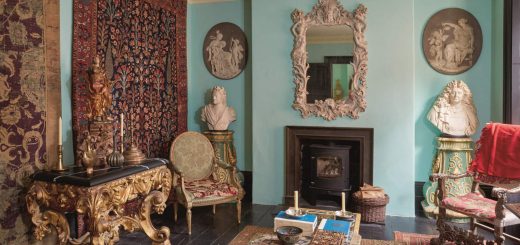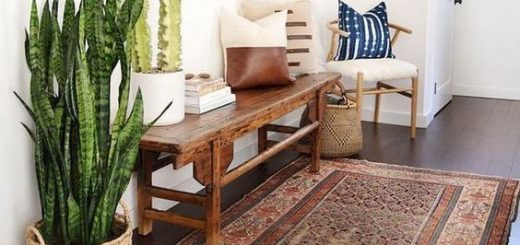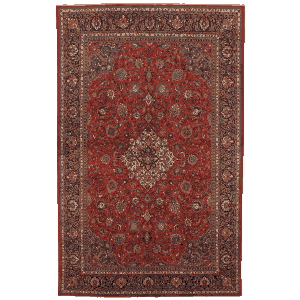What Are The Oldest Persian Carpets?
The term “Antique” is bandied about rather too freely in the world of Persian Carpets. Dealers know full well that by simply adding that term to their description the potential buyer will be struck dumb with awe and reach for their cheque book. But what, exactly, is an “Antique” and what, for that matter, do we know about the oldest oriental rugs. Furthermore, do people even still write cheques? If not have I just dated myself as an Antique? Does my bum look big in this existential crisis?
Well it so happens that the term “Antique” has a specific meaning, which is, 100 years or older. So if that dodgy rug dealer is trying to pawn you off some 1950s Baktiari made with chemical dyes as an antique then you now know the real score. Also as a rule, rugs made before and after the Second World War differ significantly and fall into two more categories of a much more vague nature. We have established that rugs made before 1913 are genuine antiques. Rugs made between 1913 and 1945 are often described as “Semi-Antique”. Rugs made after 1945 are rarely of collectible value. The simple reason for this is that after the war the Shah of Iran, in an effort to industrialize his country, brought rug production out of the villages and into factories. Chemical dyes replaced vegetable dyes. Quantity went up and quality came down.
The whole “Antique” debate leads logically into a further field of discussion, namely, what are the oldest rugs in the world? Well, who doesn’t want to know that, right?
Flatwoven rugs like kilims have been found at sites in ancient Anatolia dating back to 7000 BC. But the earliest piled rugs are another matter, certainly appearing by 1000 BC. But evidence for the existence of such rugs is limited to textual records that have miraculously survived the machinations of time. We know from textual sources, for example, that the Archaemenid Court at Pasargadae of the Persian King Cyrus the Great (c.600 BC) was full of carpets. Textual sources also explain that Alexander the Great (c. 300 BC) was dazzled by the carpets in the tomb of Cyrus, which is pictured here..

Tomb of Cyrus the Great.
A more dubious example, but tantalizing nonetheless, was the discovery of carved pavements in the Northen Palace at Nineveh back in the 19th century. Nineveh was one of the great Assyrian cities and, as an aside, was where Jonah ended up after being in the whale. How he got from the inside of a whale to Nineveh is beyond my understanding but there we have it. Now the carved pavements probably date to c.700 BC. Naturally one has to ask if these were copies or representations of carpets and if they were then we can see that quite elaborate motifs were being employed already at this early date. Just something to think about…

Possible early carpet representation carved in stone pavement. Neo-Assyrian.
We can now turn to the oldest surviving actual carpet, the famous Pazyryk Carpet. Pazyryk is located in the Altai mountaun range of Central Asia, the traditional homeland of the Turkish peoples. Throughout history there have been multiple waves of Turkish migrations from the Altai region, west towards Central Asia and Iran. Genghiz Khan was also from that neck of the woods. In the map below see the red circle to the right.

Location of Altai Mountains (circled).
A burial mound, or kurgan, was excavated at Pazyryk in 1949, revealing many treasures. Of note was this carpet, pictured below, thought to be made in Turkmenistan in Central Asia around 350 BC, before being brought east to this final resting place. The rug is woven with a type of knot known as the Gordes knot, after a town in Turkey. Center field is deep red and the border has deer and horsemen. If it ever comes up for sale it will fetch a pretty penny.

The Pyzyryk Carpet. Oldest Surviving Carpet. c.350 BC.
As incredible as it sounds a gap of almost 2000 years follows until we find our next surviving antique carpet. Once more, we must fall back on the textual data.
The first textual reference to Persian carpets is from the Sassanid Period (200-600 AD). We know that in the Sassanid Court of the Imperial Palace at Ctesiphon (near Baghdad) was a carpet of almost unbelievable dimensions. This was the “Baharestan (Garden) Carpet”, which, as would be expected, depicted a garden. The rug measured 450×90 feet and was woven with silk, gold and precious stones. The throne in the palace was covered with 30 Bahestani carpets representing the 30 days of the month and four more carpets representing the four seasons. Unfortunately all of this cut up, divided and handed out as booty with the Islamic conquest of 637 AD.
In the 8th century AD textual records indicate that Azerbaijan Province was the largest producer of carpets. Central Asia was also a big producer around Khwarazm and Bukhara. Between the 8th and 13th centuries AD there is a break in the carpet record, both physically and textually. Thousands of carpets must have been woven during this interlude although none have survived. Yet other textiles from this period depict elaborate designs that were quite likely also employed in carpet production. Finally, in the 13th century AD, Marco Polo comes to the rescue, informing us that carpet production was thriving in Iran and Central Asia and that the best carpets were being made in Konya in Turkey.

Marco Polo. He saw some stuff.
By the 15th century AD carpet weaving flourished in Iran, Syria, Egypt and Timurid Central Asia and carpets were being traded in Europe. These carpets comprised two major families or groups. First there were the Turkish Carpets with their bold geometric designs and distinctive tribal brands or guls (flowers). The second group comprise the so-called “city rugs” of Persian, which were made with fine yarn and high knot counts allowing for greater elaboration of design, with curvilinear and floral motifs.
One such example of this second group is the so-called “Ardebil Carpet” from Safavid period Persia (c.1550 AD), the oldest rug known after the Pazyryk Carpet. Believe it or not this carpet was made as a pair and they both survive. One is housed in the Victoria and Albert Museum in London and the other one is in my dining room, ahem, I mean in a museum in California. This carpet measures 17×34 feet and is finely woven at 400 knots per inch. Court carpets such as this were designed by palace artists and use stylized flower and leaf forms, as found in calligraphy of the time.

The Ardebil Carpet.
From this time on we start to see more and more carpets and carpet fragments surviving, to be kept in museums and private collections today. However, in a fascinating development the earliest carpets of this period are to be found in the paintings of the European Renaissance. Carpets from the east were prized possessions and were often included in painting backdrops. The carpets that are depicted often go by the name of the painter, for example “Holbein Carpet” or “Lotto Carpet” but many of them are instantly recognizable based on design.
This development is so curious that it warrants a few examples. Take a look at Hans Memling’s Still Life With A Jug Of Flowers from c.1500 AD.

Memling.
Now compare the carpet in the painting with this Azerbaijani Carpet from approximately the same period. Pretty amazing right?!

Antique Azerbaijani Carpet.
Another remarkable example from the same period may be seen here, in the The Alms Of Saint Antony by Lorenzo Lotto. Compare the rug in the painting…

Lotto.
Now compare the carpet in the painting with this Azerbaijani Carpet from approximately the same period. Pretty amazing again right?!

Anyway, there are scores of such examples like this and the subject is one all to itself. Needless to say the collectors who are really in the money spend a lot of time arguing over whether a carpet is a “Genuine Holbein” or not.
As a final note on rugs in paintings I should mention that during the 15th and 16th centuries AD the town of Usak in Anatolia became one of the largest centers of carpet production in history. The fame of these rugs, again, was depicted in European paintings, as in the portrait here of Henry VIII, who reputedly said “nothing matches my silk stockings quite so well as a star oushak”. Strange, but true…

A well-known painting of Henry VIII standing on a Star Oushak carpet.
During the 16th and 17th centuries we have many more surviving examples of Persian and Turkish carpets and stand on much more concrete ground when it comes to origin and design. Carpets from this period are hard to come by but they are out there and come up for sale from time to time, usually in a high-end Sothebys or Christies auction. A “Lotto” rug is going up for auction in Vienna next March and you can bet your bottom dollar it will fetch a pretty penny, or a few million euros…
And I’m not kidding. Of recent interest was the sale of the Pearl Carpet of Baroda, made in 1865. This rug was commissioned by a Maharajah and is emblazoned with over two million pearls. The rug sold for 5 million dollars and is now housed in the Museum of Islamic Art in Doha.













